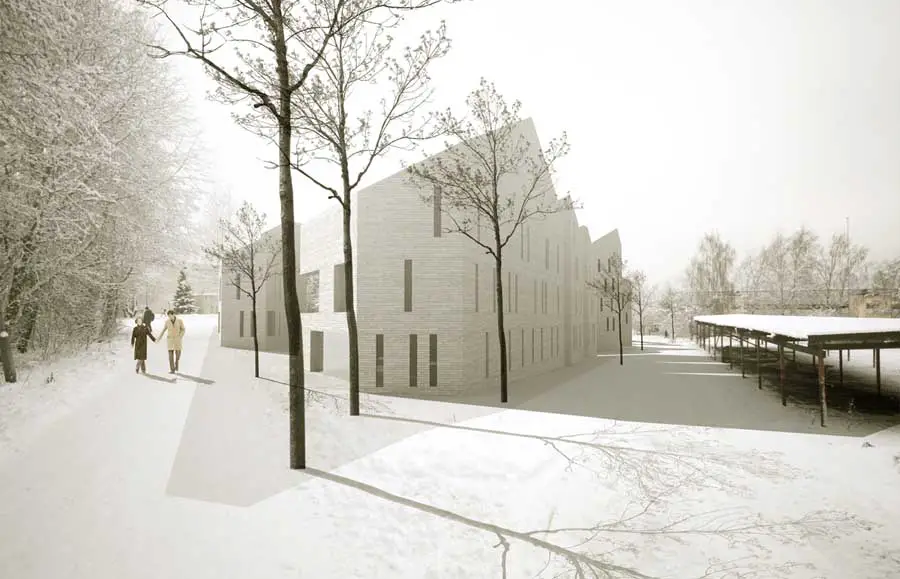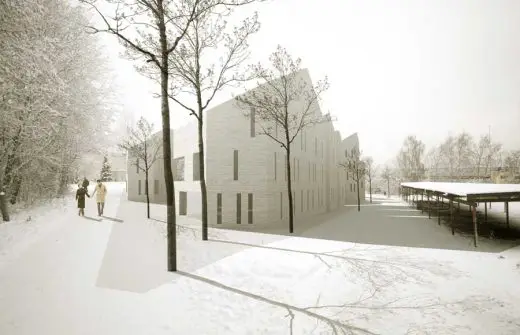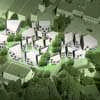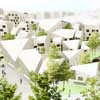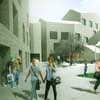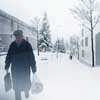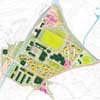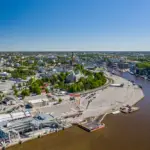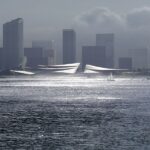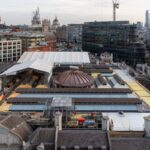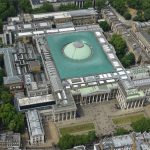Europan 10, Norwegian Building, Project News, Design Images
Europan Development in Oslo, Norway
Europan Oslo – design by Eriksen Skajaa Architects
25 Jan 2010
Europan 10 Oslo
Eriksen Skajaa Architects win EUROPAN
Location: Haugerud, Oslo, Norway
SHUFFLE
Weave, Shuffle, Flip, Intensify….Study area strategy
The main challenges in the study area are the homogenous zones that undermine cross connections and permeability. In the perspective of sustainability and ecology, large areas in the study area are under-utilised. We have developed three main strategies to facilitate a new development in the study area:
Weave
The forested paths on Haugerud are places of natural beauty and create a strong sense of place and identity. We propose to extend the network of forested paths through the study area to facilitate interconnections and permeability; both through the new development and through existing homogenous strips like the school area or the social housing.
Shuffle
We propose to shuffle the existing program in the study area to enhance the life in the area and intensify the utilization of space. Low quality space will be upgraded through this strategy. Examples could be the colonisation of garden allotments, sports programs found in the middle of housing areas and an activity center in the new development shared by the school. Penetrating these boundaries is an important step in the groundwork for a new identity.
Flip
Flip is a strategy for turning the buildings in the area towards the public space. The school buildings and the centre all turn their back on the public space. By creating public spaces we also want to give them a clear direction. In our proposal we remove most of the existing centre and make facades that open up towards the new public space.
Intensify
Some key points in the study area will be used for more specific program to create specila points of interest. The metro station is already one such point and will be given an upgrade and modern bike parking facilities. The high rise building will be converted into a health/ wellness centre. Public activity centres will be points of special interest to the young and old people that spend time in the area.
Inventing urbanity. Ecology versus intensity
We propose a new development on the site based on sustainable ecological principles and the need for a semi -urban typology that can cater to the dual need of new housing typologies (young/ elderly/ small families) and a restructuring of the local retail economy. Grid orientation, formal characteristics, facades and construction methods where determined by the passive house standard.
The shaping of the volumes brings light in between the streets and to the solar facades, but it also gives houses individual character. Through this process we have developed a clear urban typology consisting of a relatively small scale urban unit that is combined in a dense configuration. The unit can accommodate both the existing and proposed programs such as health and recreations centers.
There is flexibility within the modules to develop a wide range of housing solutions ranging from individual houses to blocks of flats. The ground floors have all been made as flexible as possible so that they can shift between housing and retail functions.
Through a high degree of fragmentation we open up possibilities that the large scale existing structures can’t cater to. We foresee in the beginning that a few small scale shops could function in the area, but we also see that this can be the framework for a development where retail and recreation colonise the entire development.
This is the concept we call shuffle. Another possible outcome is that the area becomes more a housing area and that people continue to do their shopping in the neighboring areas.
We create flexibility within the framework of a strong urban typology. Urban intensity in this context means not so much an extreme number of people on a small lot, it means living and working in close proximity to each other and shared public space.
Larger types of public space such as school yards, fields, football pitches and parking lots are abundant in the area, so we have deliberately tried to make the public spaces small enough to generate types of proximity that will be an addition to the whole area. As permeability is a strategy of the project we will add smaller volumes to create a town or Medina with buildings that can easily fit into the fabric with another program. We believe the feeling of the small scale village will strengthen the identity of Haugerud, as well as offering an attraction.
Europan 10 Oslo – Building Information
Project: Shuffle – Europan 10 competition
Location: Oslo, Norway
Year: 2009
Type: Competition
Category: Urban plan and buildings
Status: 1st prize
Size: 15000 m²
Architect: Eriksen Skajaa Architects – www.eriksenskajaa.no / mail@eriksenskajaa.no
Team: Arild Eriksen, Joakim Skajaa – Eriksen Skajaa Architects
Images: Eriksen Skajaa Architects
Europan 10 Oslo images / information from Eriksen Skajaa Architects
Location: Oslo, Norway
Norwegian Architecture
Contemporary Norwegian Architecture
Norwegian Architecture Designs – chronological list
Oslo Architecture Walking Tours
Europan 11 Vienna, Austria
Design: Borejszo, Cho, Hilgefort, Karavanas
Norwegian Architect Studios
Norwegian Architecture – Selection
Petter Dass Museum, Alstaharg, northern Norway
Design: Snøhetta
Petter Dass Museum
Kongsberg Jazz Pavilion – The Tubaloon, Kirketorget
Design: Snøhetta
Kongsberg Jazz Pavilion
Holmenkollen Ski Jump
Design: Julien de Smedt Architects
Norwegian Ski Jump Design
Comments / photos for the Europan 10 Oslo Architecture page welcome

